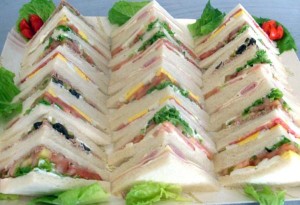A Tramezzino is a modest in size, but rich in taste, little Italian sandwich with origins in the city of Turin. In Britain it would be referred to as a “tea sandwich” — those thin sandwiches served with afternoon tea. In Italy, these sandwiches scale creative heights. The bread is always thin white bread (crusts removed). If you want to make Tramezzini at home, try Pepperidge Farm Very Thin Sliced White. At bars in Venice, there are a variety of Tramezzini fillings. All start with lots of mayonnaise (home chefs make sure to use Hellman’s Real Mayonnaise). Here are some fillings: chopped egg; sliced egg with asparagus spears; arugula and bresaola (air cured beef); tuna and sliced onion; tuna and white beans; ham and provolone. When HG makes Tramezzini at home, he adds to this list rare roast beef with slices of cornichons; bacon and turkey; sardines and sliced onion; Piquillo peppers and anchovies; smoked salmon and capers (no mayonnaise on this one– just brush the bread with a bit of olive oil). Tips: Do not stint on the mayonnaise. Do not use tomatoes — you don’t want mushy bread. Use your imagination in terms of additions and garnishes and always slice the sandwich diagonally to create 2 attractive triangles. In Italy, Tramezzini are a favorite of teenagers, businessmen in a hurry and ladies who like them with a bracing cup of tea. If you enjoy Tramezzini you will be in good company. HG’s distinguished son-in-law, Profesore/Dottore Massimo and Guido Brunetti, the detective protagonist of Donna Leon’s Venetian novels, fancy these morsels. HG favors a tray of Tramezzin with chilled Prosecco while watching his NBA heroes performing their wonders on television. Nice way to spend a chilly Sunday afternoon.
Tramezzini: An Italian Indulgence
November 7th, 2012 § 0 comments § permalink
Literary Noshing
July 26th, 2011 § 4 comments § permalink
Cuisine plays a big role in the work of two writers of crime fiction — Rex Stout and Lawrence Sanders. Stout, the creator of the cerebral private investigator/gourmand, Nero Wolfe, gives the reader full accounts of the meals prepared by Wolfe’s chef, Fritz. Fritz was a master of haute cuisine and the intricate details provided by Stout were quite appetite provoking. At one point, Stout wrote and published a book of Wolfe’s favorite recipes which was never read by HG as HG is no fan of elaborate cuisine and time consuming kitchen procedures. Sanders, on the other hand, favored plebeian fare in his fictions. HG particularly likes the “wet sandwiches” constructed by one of his protagonists, Francis X. Delaney. Brimming with sardines, tomatoes, onions, etc., these tasty items have to be eaten over the kitchen sink to avoid general messiness.
Ach…how could HG leave out all of the excellent food that saturates Donna Leon’s Venetian mysteries? Ms. Leon’s protagonist, Commisario Guido Brunetti, sure likes his vittles. His wife, Paola, sets a delicious table for Guido and their children, Raffi and Chiara. HG rarely comes to the end of a Brunetti case without cooking up a batch of linguine aglio e olio (dusted with a nice batch of chopped parsley).
Far from the gritty, urban milieu of detective fiction, Laura Ingalls Wilder used to make young HG’s palate tingle with her descriptions of farm food in the “Little House On the Prairie” books. There were extensive descriptions of the preparation and eating of smoked venison, cured hams and, best of all, a simply mouth watering (and mighty mysterious to a young, Bronx Jew) exegesis on “Johnnycakes” flavored with pork cracklings. HG was not the only one riveted by Wilder’s descriptions. In Michael Ruhlman’s and Bran Polcyn’s great cookbook “Charcuterie: The Craft of Salting, Smoking and Curing” the two give Ingall’s “Little House In The Big Woods” much attention.
Alas, like a great tease, Georges Simenon’s Inspector Maigret pauses at many cafes and bistros in his yarns but there are no memorable mentions of food. (Many Parisian cafes and bistros claim to be the hangouts of the fictional sleuth).
Alan Furst, who specializes in spy thrillers set in Europe just before the beginning of World War Two, pays some attention to Paris brasserie food (particularly in his yummy descriptions of the fictional Brasserie Heinegger ) but his heroes seem more interested in sexual dalliance (taking excessive time out, in HG’s opinion, from their dangerous spy maneuvers) than serious noshing.
But, the best book about dining is the non-fiction “Between Meals: An Appetite For Paris,” A.J. Liebling’s memoir of his life in pre-World War Two Paris. Also worth reading are the various books by M.F.K. Fisher (pay no attention to her recipes–they are inferior). 
